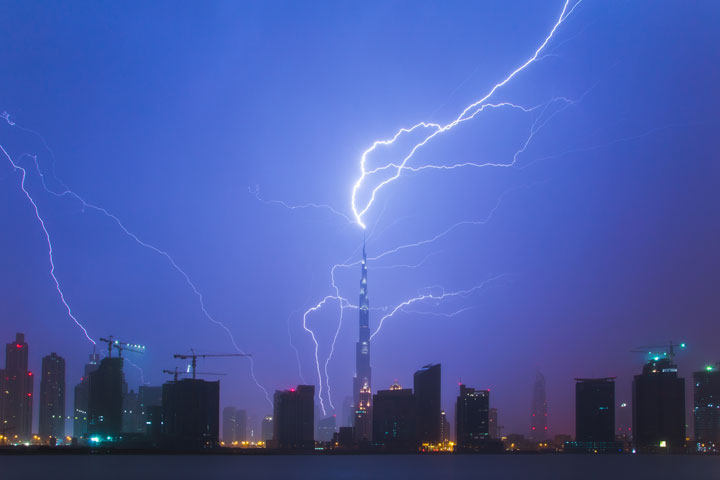Lightning Strikes Dubai

Image Credit: Michael Shainblum
In massive storm clouds, the friction between particles composed of many atoms builds up a large separation of electric charge. This, in turn, creates voltages approaching 100 million volts. When the voltage becomes this large, it can cause an explosive electric discharge that heats the gas around it to more than ten thousand degrees, causing a bright glow observed as a lightning bolt. The heat from the lightning bolts also produces sound waves, causing the clap of thunder associated with lightning. The delay we experience between seeing lightning and hearing thunder is due to how much faster light can travel (300 million meters per second) compared to sound waves in air (300 meters per second).
Listen to audio version (English)
Download high-res image file | Download caption as .zip file
Relámpagos - Dubai, Emiratos Árabes Unidos
En las nubes de tormenta masivas, la fricción entre las partículas compuestas de muchos átomos establece una separación de carga eléctrica grande. Esto, a su vez, crea voltajes que se aproximan a 100 millones de voltios. Cuando el voltaje es tan grande, puede causar una descarga eléctrica explosiva que calienta el gas alrededor de él a más de diez mil grados, provocando un resplandor brillante que se observa como un rayo. El calor de los rayos también produce ondas de sonido, causando el trueno asociado con un rayo. El retraso que experimentamos entre ver el relámpago y escuchar el trueno se debe a que la luz viaja mucho más rápido (300 millones de metros por segundo) en comparación a las ondas sonoras en el aire (300 metros por segundo).
Download high-res image file | Download caption as .zip file
Blitzeinschlag
In grossen Gewitterwolken baut die Reibung zwischen den Teilchen, die aus vielen Atomen zusammengesetzt sind, eine große elektrische Ladung auf. Diese wiederrum erzeugen Spannungen von fast 100 Millionen Volt. Durch diese enorm hohe Spannung kommt es zu einer explosiven elektrischen Entladung, die das umliegende Gas um mehr als zehntausend Grad erwärmt. Diese Entladung nimmt man als Blitz wahr. Neben Wärme erzeugt der Blitz auch Schallwellen, die als Donnerschlag zu hören sind. Die Verzögerung zwischen dem Sehen des Blitzes und dem Hören des Donners ist darauf zurückzuführen, dass Licht (300 Millionen Meter pro Sekunde) viel schneller ist als Schall (300 Meter pro Sekunde).
Download high-res image file | Download caption as .zip file



